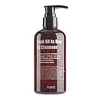What's inside
What's inside
 Key Ingredients
Key Ingredients

 Benefits
Benefits

 Concerns
Concerns

No concerns
 Ingredients Side-by-side
Ingredients Side-by-side

Water
Skin ConditioningLauramide DEA
Sodium Laureth Sulfate
CleansingTea-Lauryl Sulfate
CleansingSnail Secretion Filtrate
Skin ConditioningSodium Lauryl Sulfate
CleansingPEG-7 Glyceryl Cocoate
EmulsifyingCocamidopropyl Betaine
CleansingPotassium Cocoyl Glycinate
Sodium Cocoyl Isethionate
CleansingDipropylene Glycol
HumectantChlorphenesin
AntimicrobialCitric Acid
BufferingBetaine
HumectantPanthenol
Skin ConditioningTocopheryl Acetate
AntioxidantCamellia Sinensis Leaf Extract
AntimicrobialGinkgo Biloba Leaf Extract
Skin ConditioningCentella Asiatica Extract
CleansingDisodium EDTA
Lavandula Angustifolia Flower Extract
CleansingViola Tricolor Extract
EmollientCentaurea Cyanus Flower Extract
AstringentButylene Glycol
HumectantPentylene Glycol
Skin ConditioningMethylisothiazolinone
Preservative1,2-Hexanediol
Skin ConditioningCaprylyl Glycol
EmollientParfum
MaskingWater, Lauramide DEA, Sodium Laureth Sulfate, Tea-Lauryl Sulfate, Snail Secretion Filtrate, Sodium Lauryl Sulfate, PEG-7 Glyceryl Cocoate, Cocamidopropyl Betaine, Potassium Cocoyl Glycinate, Sodium Cocoyl Isethionate, Dipropylene Glycol, Chlorphenesin, Citric Acid, Betaine, Panthenol, Tocopheryl Acetate, Camellia Sinensis Leaf Extract, Ginkgo Biloba Leaf Extract, Centella Asiatica Extract, Disodium EDTA, Lavandula Angustifolia Flower Extract, Viola Tricolor Extract, Centaurea Cyanus Flower Extract, Butylene Glycol, Pentylene Glycol, Methylisothiazolinone, 1,2-Hexanediol, Caprylyl Glycol, Parfum
Ingredients Explained
These ingredients are found in both products.
Ingredients higher up in an ingredient list are typically present in a larger amount.
1,2-Hexanediol is a synthetic liquid and another multi-functional powerhouse.
It is a:
- Humectant, drawing moisture into the skin
- Emollient, helping to soften skin
- Solvent, dispersing and stabilizing formulas
- Preservative booster, enhancing the antimicrobial activity of other preservatives
Betaine is a common humectant (a substance that promotes retention of moisture). It's known to be gentle on the skin and can help balance hydration.
This ingredient is best for improving hydration and soothing irritated skin. Studies also show it helps even out skin tone.
Fun fact: Betaine is naturally created in the skin and body. The kind found within cosmetic products can be either plant-derived or synthetic.
Another name for betaine is trimethylglycine.
Learn more about BetaineChlorphenesin is a synthetic preservative. It helps protect a product against bacteria in order to extend shelf life. In most cases, Chlorphenesin is paired with other preservatives such as phenoxyethanol and caprylyl glycol.
Chlorphenesin is a biocide. This means it is able to help fight the microorganisms on our skin. It is also able to fight odor-releasing bacteria.
Chlorphenesin is soluble in both water and glycerin.
Studies show Chlorphenesin is easily absorbed by our skin. You should speak with a skincare professional if you have concerns about using Chlorphenesin.
Learn more about ChlorphenesinDipropylene Glycol is a synthetically created humectant, stabilizer, and solvent.
This ingredient helps:
Dipropylene glycol is technically an alcohol, but it belongs to the glycol family (often considered part of the ‘good’ alcohols). This means it is hydrating and gentle on skin unlike drying solvent alcohols like denatured alcohol.
As a masking agent, Dipropylene Glycol can be used to cover the smell of other ingredients. However, it does not have a scent.
Studies show Dipropylene Glycol is considered safe to use in skincare.
Learn more about Dipropylene GlycolDisodium EDTA plays a role in making products more stable by aiding other preservatives.
It is a chelating agent, meaning it neutralizes metal ions that may be found in a product.
Disodium EDTA is a salt of edetic acid and is found to be safe in cosmetic ingredients.
Learn more about Disodium EDTAPanthenol is a common ingredient that helps hydrate and soothe the skin. It is found naturally in our skin and hair.
There are two forms of panthenol: D and L.
D-panthenol is also known as dexpanthenol. Most cosmetics use dexpanthenol or a mixture of D and L-panthenol.
Panthenol is famous due to its ability to go deeper into the skin's layers. Using this ingredient has numerous pros (and no cons):
Like hyaluronic acid, panthenol is a humectant. Humectants are able to bind and hold large amounts of water to keep skin hydrated.
This ingredient works well for wound healing. It works by increasing tissue in the wound and helps close open wounds.
Once oxidized, panthenol converts to pantothenic acid. Panthothenic acid is found in all living cells.
This ingredient is also referred to as pro-vitamin B5.
Learn more about PanthenolWater. It's the most common cosmetic ingredient of all. You'll usually see it at the top of ingredient lists, meaning that it makes up the largest part of the product.
So why is it so popular? Water most often acts as a solvent - this means that it helps dissolve other ingredients into the formulation.
You'll also recognize water as that liquid we all need to stay alive. If you see this, drink a glass of water. Stay hydrated!
Learn more about Water